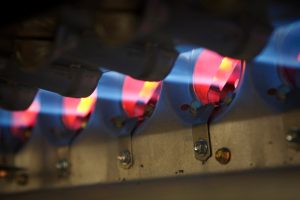How does your gas furnace light the burners when it starts a heating cycle? In your mind, you may see a standing pilot light doing the job. That makes sense because standing pilot lights did this job for many decades and it’s just become part of how we think about furnaces.
But chances are high that your furnace doesn’t have a standing pilot light at all. The pilot light is becoming a relic of the past, replaced with electronic ignition systems.
We’re going to look into this change and explain why electronic ignition is now favored over conventional standing pilot lights.
The Problem With Standing Pilot Lights
There’s no question that standing pilot lights can do the basic job expected of them. The flame of the pilot light burns throughout the winter season, ready to ignite the burners as soon as gas starts to flow to them.
Unfortunately, standing pilot lights are energy wasters. They burn all winter so people don’t have to keep lighting them each time they need heat. But this means a steady waste of natural gas. Pilot lights create other problems as well, such as unreliability. Pilot lights often go out, forcing people to go through steps to re-light them just to get some heat. They also create safety problems such as unintended combustion within the furnace leading to flame roll-out.
No, pilot lights weren’t ideal, and something was eventually going to replace them. Enter the electronic ignition systems.
Electronic Ignition
There are two types of electronic ignition systems currently used in furnaces:
- Hot-surface igniters: This electronic ignition system creates heat through electrical resistance (current flowing through metal filaments which then turn hot) and then uses that heat to directly light the burners. This is the more common of the two systems.
- Intermittent pilot lights: These systems use pilot lights, but they only have the pilot light on for a short duration. An electric spark causes the pilot to turn on when there’s a demand for heat. Once the burners are ignited, the pilot light goes out again.
The Benefits of Electronic Ignition
- Energy efficiency: The amount of energy either type of igniter uses is minimal. The igniter only needs to activate briefly when the furnace turns on.
- Safety: Industry safety regulations have changed over time, and electronic ignition is designed to meet those increased standards for safe furnaces.
- Smart home integration: Electronic components can be integrated into smart home systems for better furnace performance.
Furnace Upgrade
If you have a furnace that uses a pilot light, it’s probably already quite old. We recommend you have a furnace this old replaced. Not only will the new furnace have the benefits of an electronic ignition system, but it will also have better energy efficiency and newer features that will help heat your home better than ever.
We install the best quality Carrier furnaces, many of which have AFUE ratings of 90% or higher and which use effective hot surface igniters. Talk to us today if you’re considering a new heating installation in Plymouth, MN to replace your old furnace.
Rely on Residential Heating and Air Conditioning and you’ll “Feel the Difference”! Serving The Twin Cities Since 1991.

